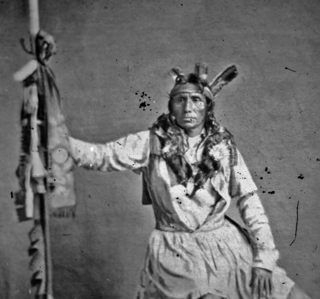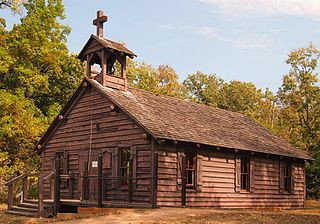
Yellow Medicine County is a county in the southwestern part of the U.S. state of Minnesota. Its eastern border is formed by the Minnesota River. As of the 2020 census, the population was 9,528. Its county seat is Granite Falls.

Lac qui Parle County is a county in the southwestern part of the U.S. state of Minnesota. As of the 2020 census, the population was 6,719. Its county seat is Madison. The largest city in the county is Dawson.
Odessa Township is a township in Big Stone County, Minnesota, United States. The population was 147 as of the 2000 census. Odessa Township was named after Odesa, Ukraine.

Dawson is a city in Lac qui Parle County, Minnesota, United States. The population was 1,466 at the 2020 census.

Madison is a city in and the county seat of Lac qui Parle County, Minnesota, United States, along the 45th parallel. The population was 1,518 at the 2020 census. It proclaims itself to be the "lutefisk capital of the USA."
Providence Township is a township in Lac qui Parle County, Minnesota, United States. The population was 186 at the 2000 census.

The Lac qui Parle River is a tributary of the Minnesota River, 118 miles (190 km) long, in southwestern Minnesota in the United States. A number of tributaries of the river, including its largest, the West Branch Lac qui Parle River, also flow in eastern South Dakota. Via the Minnesota River, the Lac qui Parle River is part of the watershed of the Mississippi River, draining an area of 1,156 square miles (2,990 km2) in an agricultural region. Slightly more than two-thirds of the Lac qui Parle watershed is in Minnesota.

Little Crow III was a Mdewakanton Dakota chief who led a faction of the Dakota in a five-week war against the United States in 1862.

Lac qui Parle State Park is a state park of Minnesota, United States, near Watson. Lac qui Parle is a French translation of the native Dakota name, "Mde Lyedan," meaning "lake that speaks".

Minnesota State Highway 40 (MN 40) is a 72.723-mile-long (117.036 km) state highway in west-central Minnesota, which travels from South Dakota Highway 20 (SD 20) at the South Dakota state line near Marietta and continues east to its eastern terminus at its intersection with County State-Aid Highway 5 (CSAH 5) in Willmar.

Joseph Renville (1779–1846) was an interpreter, translator, expedition guide, Canadian officer in the War of 1812, founder of the Columbia Fur Company, and an important figure in dealings between settlers of European ancestry and Dakota (Sioux) Natives in Minnesota. He contributed to the translation of Christian religious texts into the Dakota language. The hymnal Dakota dowanpi kin, was "composed by J. Renville and sons, and the missionaries of the A.B.C.F.M." and was published in Boston in 1842. Its successor, Dakota Odowan, first published with music in 1879, has been reprinted many times and is in use today.

The Lac qui Parle County Courthouse, located at 600 6th Street in Madison, Lac qui Parle County in the U.S. state of Minnesota is a Richardsonian Romanesque style building featuring a high central tower, built in 1899 at a cost of $30,689.

This is a list of the National Register of Historic Places listings in Lac qui Parle County, Minnesota. It is intended to be a complete list of the properties and districts on the National Register of Historic Places in Lac qui Parle County, Minnesota, United States. The locations of National Register properties and districts for which the latitude and longitude coordinates are included below, may be seen in an online map.

Buechner & Orth was a St. Paul, Minnesota-based architectural firm that designed buildings in Minnesota and surrounding states, including 13 courthouses in North Dakota. It was the subject of a 1979 historic resources study.

Lac qui Parle Mission is a pre-territorial mission in Chippewa County, Minnesota, United States, which was founded in June 1835 by Dr. Thomas Smith Williamson and Alexander Huggins after fur trader Joseph Renville invited missionaries to the area. "Lac qui Parle" is the French translation of the native Dakota name, "Mde Lyedan," meaning "lake which speaks". In the 19th century, the first dictionary of the Dakota language was written, and part of the Bible was translated into that language for the first time at a mission on the site of the park. It was a site for Christian missionary work to the Sioux for nearly 20 years. Renville was related to and had many friends in the Native community, and after his death in 1846, the mission was taken over by the "irreligious" Martin McLeod. The relationship between the mission and the Dakota people worsened, and in 1854 the missionaries abandoned the site and relocated to the Upper Sioux Agency.
Lac qui Parle is an unincorporated community in Lac qui Parle Township, Lac qui Parle County, Minnesota, United States. Lac qui Parle Village is the county's first permanently settled community, starting in 1868.

Jacob F. Jacobson was an American businessman and politician.

The Swensson Farm Museum is a historic farmstead located in Chippewa County, Minnesota, six miles east of Montevideo. Established by Norwegian immigrants Olof and Ingeborg Swensson in the 1880s, the farmstead today serves as open-air museum operated by the Chippewa County Historical Society showcasing pioneer life and Swedish-American heritage.

Lac qui Parle County, Minnesota had two battles for its county seat during the 1800s. The first was between Williamsburg and Lac qui Parle Village. The second was between Dawson and Madison which culminated in the county courthouse being stolen and a case being brought to the Minnesota Supreme Court.
Rudie M. "R.M." Saltness was an American politician and lawyer.















